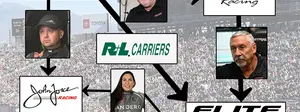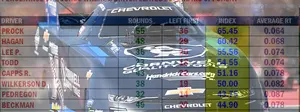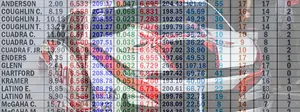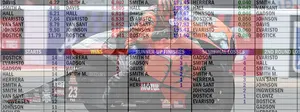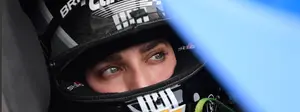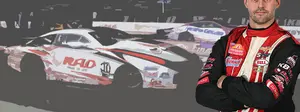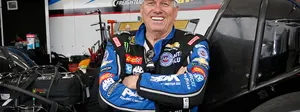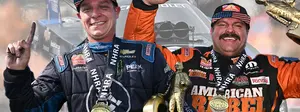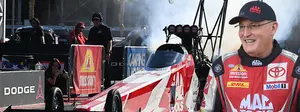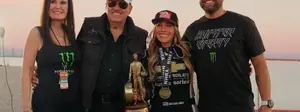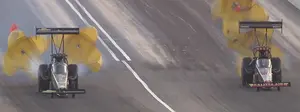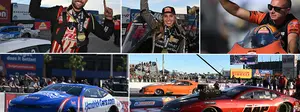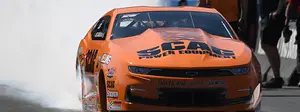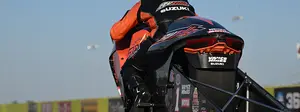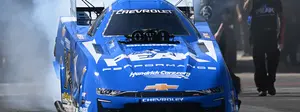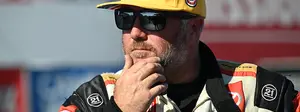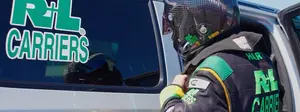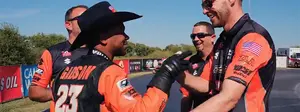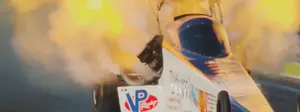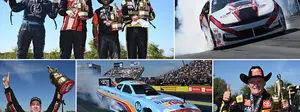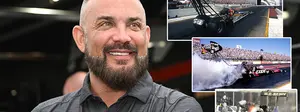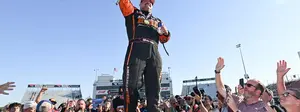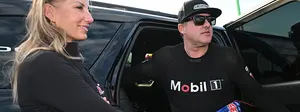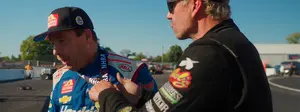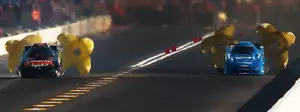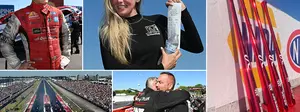

Tenacious Terry Haddock keeps his two-car team going through sheer willpower
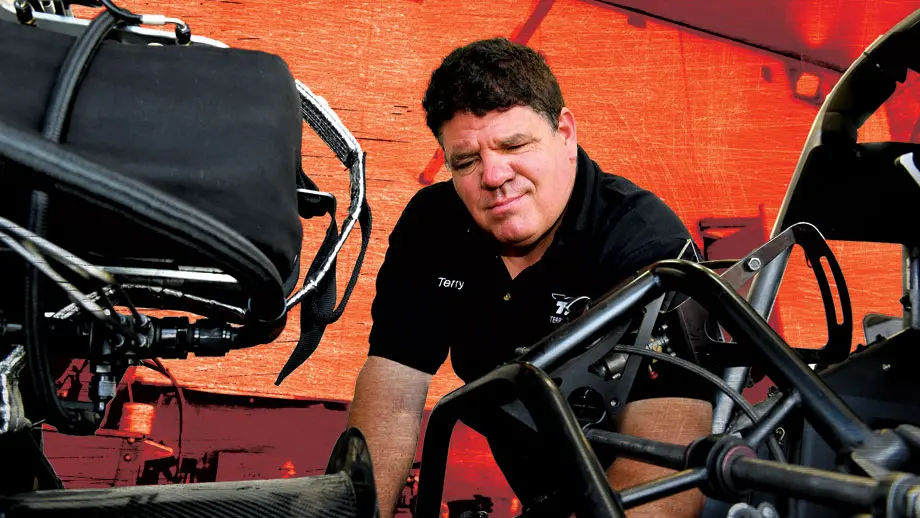
Merriam-Webster defines “tenacious” as the quality of being “persistent in maintaining, adhering to, or seeking something valued or desired.”
It’s an especially apt adjective for Terry Haddock, nitro-racing’s unbreakable “little guy” racer. It’s hard to think of anyone who has tried harder than Haddock on a more consistent basis without seeing more than just a brief glimmer of success yet continues to show up week in and week out just to try to get there.
Imagine the commitment it must take to travel to every event without a sponsor and, honestly, without a real chance of winning. Now imagine doing it with two cars: a Funny Car and a Top Fuel dragster. He has driven both, but he prefers the Funny Car, hands down.
What drives Haddock is the belief in himself that, given even a modest helping hand, he could really be someone in the sport and not just the guy who typically holds down a bottom-quarter spot in the 16-car field and serves as a first-round warmup for his better-heeled opponents.
It’s his carrot, his “something valued or desired.”
He not only believes it but has sacrificed greatly for it: money, parts, relationships, personal injury.
That’s tenacious. That’s Terry Haddock.
::::

Haddock fields two cars, the Mustang Funny Car he drives and the Top Fueler that he rents, this year to up-and-comer Cameron Ferre.
If Haddock is known for something other than being the little engine that thinks it can, he has also gained a bit of a reputation for helping keep the Top Fuel field full. Over the last decade, he has either introduced, mentored, or helped improve the racing careers of several Top Fuel drivers, including his ex-wife, 2014 Automobile Club of Southern California Road to the Future Award candidate Jenna; sponsor-turned driver Jim Maroney; fellow journeyman Terry Totten; and, this year, Ferre.
Haddock has qualified at 16 of the 19 events on the schedule, and Ferre’s dragster made the show 15 of 19 times (with Todd Paton subbing for him in Reading). Between them, they don’t have a round-win this season, but they soldier on and both cars have gotten better as the season has progressed. The Funny Car had run 4.0s at the last three events
Haddock’s racing budget — a literal fraction of what powers the engines of his opponents — comes in small installments, some from profits from his company, the self-descriptive Lonestar Aluminum Block Repair, and some from friends whose decals adorn his otherwise jet-black Funny Car. Sometimes, putting their names on the side of his car is the only way he can repay them for services rendered.
“You look at the car, and there aren’t a lot of stickers on it just mostly my friends,” he admits. “There’s not any money, but if we stop, it’s over completely.”
He buys used parts from his competitors and makes them last as long as he can. The money to get the rig up and down the highway, pay the bills, and replenish the parts comes from the money he gets when the cars qualify: $10,000 for a first-round finish or, as a consolation prize, $7,500 for not qualifying.
“It’s a bad business model, but we’re making it work,” he said with a grin. “I think we’re doing a phenomenal job with the resources we have. We’re surviving on checks. It’s probably the stupidest business model out there, but it keeps me going. We don’t come away with a profit per se because it takes every set to just keep going.
“If I had a couple of hundred grand, imagine what I could do.”
A round-win here and there would be nice, but when you qualify in the bottom fourth of the field, you’re going to draw the toughest of the tough in round one. Haddock has had to face two-time world champ Robert Hight four times this season in the opening stanza.
“I look at it as you have to try; if you don’t try, you shouldn’t be there at all,” he said. “I don't want to be the guy that is just there to take the first-round loser check.”
Haddock, who won the IHRA Funny Car championship in 2008, has just seven round-wins in 115 NHRA matchups, but he has beaten the best: John Force, Tony Schumacher (twice), Shawn Langdon, and Gary Scelzi. His opponents know that if they make a mistake, Haddock is going to be there to capitalize.
Haddock knows that all of the years on the road — he has been running a Funny Car since 1998 and has competed at more than 250 races — and getting his butt kicked in round one is the dues-paying part of the deal. He’s realistic enough to know that success doesn’t come overnight — maybe for a good reason.
“In the beginning, when you first start you, you think, ‘Wow, I’ve got a car and the trailer; I should have that $2 million sponsor,’ right? But after all the years, you realize that you also have to know how to run it when that sponsor comes. If I would have gotten a sponsor the first year I had all this stuff, I’d be out of business by now. You have to learn all these lessons first. You ask what keeps me going. I don’t wanna lose my place in line when a sponsor deal comes. I gotta be closer to the front of the line than the back. I’ve paid my dues.”
::::

In the age of social-media ready, corporate-spokesperson-perfect drivers, Haddock is a bit of an anomaly. At 5 foot 10 and 235 pounds, he’s built like a fireplug with a prizefighter’s face. He looks more like the guy you probably want on your side in a barfight or in your starting backfield.
Although he has lived in Texas for the last 10 years, he’s originally from Hackettstown, N.J., where he admits he was a bit of a hellraiser.
“I wasn’t exactly a model citizen, and I spent more time in trouble fighting, street racing, and doing things I shouldn’t do, and a local cop steered me in the right direction,” he said. “He raced cars, so we ended up out of the racetrack. I ran a stock car for half a summer, but when you’re a kid, it’s hard to get your buddies to help you with a stock car or you’d have to pull in and change a tire yourself, which kinda defeats the purpose. In drag racing, you learn that you could do it yourself or with one or two of your friends, and they like dragstrips rather than cleaning mud off the tires. And once I started racing on the racetrack, I realized I wasn’t gonna be out on the street doing stupid stuff.”
Haddock never forgot that Hackettstown police officer, and after a 2016 shooting in Dallas claimed the lives of five police officers, Haddock felt moved to make a statement. At several events, Haddock’s cars have flown a “Back The Blue” paint scheme in memory of law-enforcement personnel who lost their lives in the line of duty.
Haddock got his first Funny Car in 1998 and got some tuning advice from wily veteran Paul Smith and, later, Terry Manzer. He ran Funny Cars exclusively through 2007, then started running mixed partial seasons in both Top Fuel and Funny Car, strategically picking and choosing based on field size and strength. He didn’t win his first round of racing until 2003 when he upset Force in round one in Reading in what was approximately his 40th event. He ran 22 events last year — 12 in Top Fuel and 10 in Funny Car — but scored just one round-win: He was in the other lane at the Winternationals when Brittany Force crashed in round one.
He moved to Texas 10 years ago in the wake of a divorce, going there to heal the emotional scars of only having partial custody of his son, McKailen, who is a constant sight at the races and always joins his dad for driver introductions, and the physical scars racing can bring.
Because of a nasty fire in Memphis in 2000 that left him in a burn ward for two months, he doesn’t do well in cold, damp climates — “I get pneumonia at the drop of a hat,” he admits — so Texas suits him fine. It’s also where he met Jenna, who became a darling of fans and, with Haddock’s guidance, became a minor celebrity in the sport.
Drag racing has taken a lot from Haddock. His second marriage, to Jenna, also ended as a result of racing, but Haddock is the poster child for the glass half full.
“Racing has taken a toll, but I think that it has been better than it has been worse,” he rationalizes. “Racing has given me an amazing life. People don’t realize that the relationships that you build, the friends that you make, and the people you meet are forever.
“I’m blessed to have gotten to live it like this. I don’t make a great living, but I race cars for a living. I mean, I work hard, but the other guy goes to the factory every day, works just 10 hours, then comes home and drinks beer. We travel the country. I’ve seen the world and get to do cool stuff. It ain’t always as perfect as we’d like it, but it won’t be if you quit.”
::::

Quit is just not in Haddock’s vocabulary.
He lost nearly his entire race car at last year’s Auto Club NHRA Finals when a broken inner head stud over-pressurized the oil tank and caused in to blow, engulfing the car and Haddock in a fireball. He rode it out to the sand trap, then calmly exited the car and trudged through the ankle-deep trap, looking over his shoulder several times at the smoldering hulk. Only the chassis was salvageable.
“After the fire, I knew I either had to quit or get someone to help me,” he said. “I have guys, good guys, who help me, but they’re new; I’m 25 years ahead of them. I just can’t afford experienced guys. I realized that when I have someone in the dragster, and I can watch; it always goes down the track, not on fire, and qualifies most of the time. I have no one to keep me safe like I keep them safe, so I hired Johnny West.
“He’s showing me lots of things. I’m still tuning it, but Johnny has come in and cleaned up everything and organized it, and he is showing me how important even the smallest detail is. All of a sudden, the car is worlds better. He didn’t come in and tell me how stupid I was and how I need to change everything, which some people might do. He said, ‘You’ve got some nice parts, and you’re pretty smart, so let me help you do what you’re already doing.’ It’s been a lot of fun.”
And it not only shows on the track but what’s not on the track. Haddock, derisively and, he admits, not unfairly, was called “a leaker” earlier in his career, has just one oildown penalty this year, the result of a crewman error in the pits.
“We’ve all been leakers from time to time; nobody ever goes up there and intends to have a problem,” he notes. “This is incredibly hard to do and survive, but, you know, it’s never been our goal to leak or make a mess or do stupid things, and, obviously, we just can’t afford to hurt parts.”
::::

As he mentioned, getting one or both cars qualified is important, almost a necessity despite NHRA’s generous non-qualifier stipend designed to do just what it does for guys like Haddock.
“I try to set up the dragster for one run Friday and one run Saturday,” he explained. “Hopefully, we qualify on the first run. It’ll run 4-flat to 3.90 just about anywhere. If you can do it on one run and you qualify and get to run first round, then it’s $5,000 a run. If it takes you two qualifying passes, then you’re getting $3,300 or so a run, which is bad math with these cars. If you don’t qualify, you get $7,500, so that’s the same per-run money, but of course, we come there to race on Sundays and, hopefully, win a round or two and put on a show for the fans because that’s what the job is.
“The whole idea of running the dragster is to generate money to run the Funny Car, but I only have one group of guys between the two cars; most times, we don’t have enough for one team. It takes all the help from the other teams that takes everything that everybody does to keep us out there, but at least, I’m out there.
We don’t know long we can go, but we’ll go until we can’t. We can’t afford to run all of the sessions, yet without the kind of financing you need to do it right, we’re doing what we can with what we have. We work as hard as we can and give it everything we’ve got.”
And life on the road ain’t easy.
“We’re trying really hard; I’m proud of what we’ve accomplished this year. It’s been one struggle after another,” he says exhaustedly. “When we left Epping [the NHRA New England Nationals] earlier this year, the Peterbilt blew a head gasket in Memphis. By the time we were out of there, it was $23,000. I had to lease a truck from Schumacher to make the Western Swing. I wanted to make it to all of the races. “You know, if the sport disappears tomorrow, at least I can say I ran a whole season once.
“If the outside world, the people who watch the TV show, knew what this little team goes through to race compared to what the big guys do, I think we’d have more of a following.
“I think most people would throw their arms up and say, ‘Screw it,’ but I have all my eggs in this basket. We’re going to go until we physically can’t.”
Johnny West: Nitro Gunslinger

Johnny West sounds like the kind of name you’d expect to encounter in a Western novel, and he has spent a lifetime as a hired gun. He has been around drag racing since the 1970s when he was driving instead of tuning. He and brother Jim had a pair of Funny Cars, and West later drove for respected owners, including Roland Leong and fellow Arizonian Johnny Loper and reached three finals without a win.
West hung up his driving gloves years ago and has tuned fuel cars for the likes of Don Schumacher Racing, Don Prudhomme’s Snake Racing operation, and Kalitta Motorsports, and drivers like Jack Beckman, Tommy Johnson Jr., Whit Bazemore, Jim Epler, Chuck Etchells, Richard Hartman, Doug Herbert, David Baca, Bob Vandergriff Jr., and many, many more, sometimes as the crew chief, sometimes as a consultant and overseer. In the last few years, he has eschewed the big teams in favor of lesser-funded teams, who can most benefit from his steady hand, including those of Jeff Diehl, John Bojec, and Greg Carrillo.
West may well be Haddock’s biggest fan and a great mentor.
“He’s really a pretty sharp kid — there’s very little he doesn’t know about this race car — and he’s like McGyver: He knows how to fix something with nothing,” said West earlier this year. “The real reason I’m here is that I look at him as another John Force. I really think that if he gets a little bit of help, watch out. You give him $150 grand, he’d be there.
“When I first started with him in Pomona, I asked him, ‘If someone walked up to you and gave you $150 grand, what would you do?’ and he said, ‘Add some people. We need people,’ and that was the exact answer I wanted to hear. Not another set of heads, another block, another blower — people. He’s got his head on right.”
This article appears in the Oct. 11, 2019 issue of NHRA National Dragster magazine























